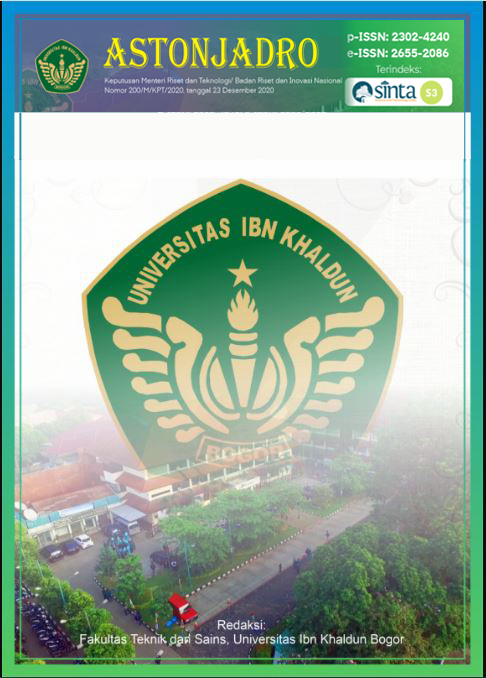Modeling Study of Interaction between Fluid Flow and Pipe Wall Formed in Piping Erosion Phenomenon with SPH Method
Keywords:
piping erosion; friction coefficients; poiseuille number; SPH method; fluid-solid interaction.Abstract
This study observes the interaction between fluid flow and the solid particles using Smoothed Particle Hydrodynamics (SPH) as a numerical approach with DualSPHysics platform and the flow assumed as a laminar flow with Re of 25, 50, and 100. As an approach study of internal piping erosion phenomenon, there are two types of pipes simulated, pipe with smooth wall and rough wall with different geometry and height of roughness. The geometry of roughness simulated are semi – circular ribs, triangular ribs, and rectangular ribs. The evaluated output of this research is the friction coefficient and velocity distribution occurring. In the case of flow through smooth wall, it is found that the increase of Reynolds number causes the decrease of friction coefficient. The next case of flow through rough walls shows that the height and shape of roughness affect the friction coefficient and velocity contour of the flow.
References
Domínguez JM, Fourtakas G, Altomare C, Canelas RB, Tafuni A, García-Feal O, Martínez-Estévez I, Mokos A, Vacondio R, Crespo AJC, Rogers BD, Stansby PK, Gómez-Gesteira M (2021), DualSPHysics: from fluid dynamics to multiphysics problems, Computational Particle Mechanics, 9 (5), pp. 867-895.
English, Aaron & Domínguez, José & Vacondio, Renato & Crespo, Alejandro & Stansby, P.K. & Lind, Steven & Chiapponi, L. & Gesteira, Moncho (2021), Modified dynamic boundary conditions (mDBC) for general-purpose smoothed particle hydrodynamics (SPH): application to tank sloshing, dam break and fish pass problems, Computational Particle Mechanics 9 (5).
G. R Liu, M. L (2003), Smoothed Particle Hydrodynamics: A Meshfree Particle Method, World Scientific Publishing Company, Singapore.
Joseph O’Connor, Benedict D. Rogers (2021), A fluid–structure interaction model for free-surface flows and flexible structures using smoothed particle hydrodynamics on a GPU, Journal of Fluids and Structures, vol. 104.
KANDLIKAR, S (2005), Roughness effects at microscale – reassessing Nikuradse’s, BULLETIN OF THE POLISH ACADEMY OF SCIENCES 53 (4).
Katopodes, N. D (2018), Free-Surface Flow, 1st ed, Butterworth-Heinemann, Oxford.
Kays, W. & M. Crawford (2004), Convective heat and mass transfer, 4th ed, McGraw-Hill, London,.
Kumar, Rajneesh & Goel, Varun & Kumar, Anoop (2016), Thermal and fluid dynamic characteristics of flow through triangular cross-sectional duct: A review, Renewable and Sustainable Energy Reviews, 61, pp. 123-140.
Lixia Qu, Christoffer Norberg, Lars Davidson, Shia-Hui Peng, Fujun Wang (2013), Quantitative numerical analysis of flow past a circular cylinder at Reynolds number between 50 and 200, Journal of Fluids and Structures, 39, pp 347-370.
Mahrous, A. F., S. Mahmoud, R. K. Al-dadah, & A. M. El-syaed (2011), Numerical investigation of laminar flow in micro-tubes with designed surface roughness, In 3rd Micro and Nano Flows Conference, August 22–24, 2011.
Monaghan, J. J. (1992), Smoothed Particle Hydrodynamic, Annual Review of Astronomy and Astrophysics, 30 (1), pp 543-547.
Monaghan, J. J., & Lattanzio, J. C (1985), A refined particle method for astrophysical problems. Astronomy and Astrophysics.
Nikuradse, J (1950), LAWS OF FLOW IN ROUGH PIPES, NATIONAL ADVISORY COMMITTEE FOR AERONAUTICS.
Potter, M., Wiggert, D., & Ramadan, B (2012), Mechanics of Fluids, Cengage Learning, USA.
Rodrigo Surmas, Luı́s O.E. dos Santos, Paulo C. Philippi (2004),Lattice Boltzmann simulation of the flow interference in bluff body wakes,Future Generation Computer Systems, 20(6), pp. 951-958.
S. Geara, S. Martin, S. Adami, W. Petry, J. Allenou, B. Stepnik, O. Bonnefoy (2022). A new SPH density formulation for 3D free-surface flows. Computers & Fluids, 232.
Sjah, Jessica & Vincens, Eric & Marongiu, Jean-Christophe, 2D numerical modelling of the HET: Hydrodynamic forces on the pipe wall particles, Scour and Erosion - Proceedings of the 7th International Conference on Scour and Erosion, 2-4 December 2014.
Timothy P. Brackbill & Satish G. Kandlikar (2007), Effect of Sawtooth Roughness on Pressure Drop and Turbulent Transition in Microchannels, Heat Transfer Engineering, 28:8-9, pp. 662-669.
Wendland, H. (1995), Piecewiese polynomial, positive definite and compactly supported radial functions of minimal degree. Advances in Computational Mathematics 4.
Wonjoo, Moon & Sukbeom, You & Oakkey, Min (2002). Analysis of Hagen-Poiseuille flow using SPH. KSME International Journal, 16, pp.395-402.
Zhang, C., Y. Chen, & M. Shi, Effects of roughness elements on laminar flow and heat transfer in microchannels (2010). Chemical Engineering and Processing: Process Intensification, vol. 49 no.11, pp. 1188–1192.
Downloads
Published
How to Cite
Issue
Section
License
Copyright (c) 2024 ASTONJADRO

This work is licensed under a Creative Commons Attribution-ShareAlike 4.0 International License.
Paper submitted to ASTONJADRO is the sole property of the Astonjadro Journal. Unless the author withdraws the paper because he does not want to be published in this journal. The publication rights are in the journal Astonjadro.ASTONJADRO
LICENSE
This work is licensed under a Creative Commons Attribution-ShareAlike 4.0 International License.
Based on a work at http://ejournal.uika-bogor.ac.id/index.php/ASTONJADRO













